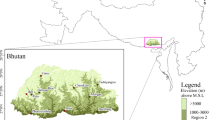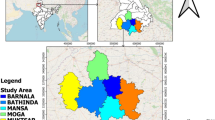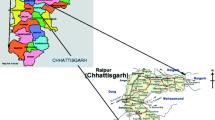Abstract
Precipitation is one of the most significant components for the basin’s hydrological cycle. Numerous features of a basin’s water circulation may be affected by the chronological, geographical, and seasonal fluctuation of precipitation. It could be an important factor that influences hydrometeorological phenomena including floods and droughts. In this research, the innovative trend risk analysis (ITRA), innovative trend pivot analysis (ITPAM), and trend polygon star (TPS) methodologies of visualizing precipitation data are used to detect precipitation changes at six stations in Algeria’s Wadi Ouahrane basin from 1972 to 2018. ITRA graphs show the direction of the precipitation trend (increasing–decreasing) and the trend risk class. Disparities in the polygons generated by the arithmetic mean and standard deviation ITPAM graphs demonstrate variations in precipitation seasonally and in the seasonal precipitation trends (increasing or decreasing) between sites. The TPS maps depict monthly variations in precipitation and highlight the autumn and spring transitions between the dry and wet seasons.











Similar content being viewed by others
Data availability
The datasets generated during and/or analyzed during the current study are available from the corresponding author on reasonable request.
References
Abu Hammad, A. H. Y., Salameh, A. A. M., & Fallah, R. Q. (2022). Precipitation variability and probabilities of extreme events in the eastern Mediterranean region (Latakia governorate-Syria as a case study). Atmosphere, 13, 131.
Achite, M., Ceribasi, G., Ceyhunlu, A. I., Wałęga, A., & Caloiero, T. (2021a). The innovative polygon trend analysis (IPTA) as a simple qualitative method to detect changes in environment—Example detecting trends of the total monthly precipitation in semiarid area. Sustainability, 13(22), 12674.
Achite, M., Wałęga, A., Toubal, A. K., Mansour, H., & Krakauer, N. (2021b). Spatiotemporal characteristics and trends of meteorological droughts in the Wadi Mina basin. Northwest Algeria. Water, 13(21), 3103.
Achite, M., & Caloiero, T. (2021). Analysis of temporal and spatial rainfall variability over the Wadi Sly basin. Algeria. Arabian Journal of Geosciences, 14, 1867.
Alashan, S. (2018). An improved version of innovative trend analyses. Arabian Journal of Geosciences, 11, 50.
Alashan, S. (2020). Testing and improving type 1 error performance of Şen’s innovative trend analysis method. Theoretical and Applied Climatology, 142, 1015–1025.
Ali, R. O., & Abubaker, S. R. (2019). Trend analysis using Mann-Kendall, Sen’s slope estimator test and innovative trend analysis method in Yangtze River basin, China. International Journal of Engineering & Technology, 8(2), 110–119.
Almazroui, M., & Şen, Z. (2020). Trend analyses methodologies in hydro-meteorological records. Earth Systems and Environment, 4(4), 713–738.
Asadieh, B., & Krakauer, N. Y. (2015). Global trends in extreme precipitation: Climate models versus observations. Hydrology and Earth System Sciences, 19(2), 877–891.
Blain, G. C. (2013). The Mann-Kendall test: The need to consider the interaction between serial correlation and trend. Acta Scientiarum. Agronomy, 35(4), 393–402.
Ceribasi, G., & Ceyhunlu, A. I. (2021). Analysis of total monthly precipitation of Susurluk Basin in Turkey using innovative polygon trend analysis method. Journal of Water and Climate Change, 12(5), 1532–1543.
Ceribasi, G., Ceyhunlu, A. I., & Ahmed, N. (2021a). Innovative trend pivot analysis method (ITPAM): A case study for precipitation data of Susurluk Basin in Turkey. Acta Geophysica, 69(4), 1465–1480.
Ceribasi, G., Ceyhunlu, A. I., & Ahmed, N. (2021b). Analysis of temperature data by using innovative polygon trend analysis and trend polygon star concept methods: A case study for Susurluk Basin. Turkey. Acta Geophysica, 69(5), 1949–1961.
Collins, M., Knutti, R,, Arblaster, J., Dufresne, J. L., Fichefet, T., Friedlingstein, P., & Booth, B. B. (2013). Long-term climate change: Projections, commitments and irreversibility. In: Proceedings of Climate Change 2013-The Physical Science Basis: Contribution of Working Group I to the Fifth Assessment Report of the Intergovernmental Panel on Climate Change. Cambridge University Press, 1029–1136.
Croitoru, A. E., & Toma, F. M. (2010). Trends in precipitation and snow cover in central part of Romanian plain. Geographia Technica, 9(1), 1–10.
Door, J. P. (2011). Rapport d’information déposé en application de l’article 145 du règlement par la commission des affaires sociales en conclusion des travaux de la mission sur le Médiator et la pharmacovigilance. Assemblée nationale.
Güçlü, Y. S. (2018). Multiple Şen-innovative trend analyses and partial Mann-Kendall test. Journal of Hydrology, 566, 685–704.
Güçlü, Y. S., Şişman, E., & Dabanlı, İ. (2020). Innovative triangular trend analysis. Arabian Journal of Geosciences, 13(1), 1–8.
Harka, A. E., Jilo, N. B., & Behulu, F. (2021). Spatial-temporal rainfall trend and variability assessment in the Upper Wabe Shebelle River Basin, Ethiopia: Application of innovative trend analysis method. Journal of Hydrology: Regional Studies, 37, 100915.
Hu, Y., & Wang, S. (2021). Associations between winter atmospheric teleconnections in drought and haze pollution over Southwest China. Science of the Total Environment, 766, 142599.
Khedimallah, A., Meddi, M., & Mahé, G. (2020). Characterization of the interannual variability of precipitation and runoff in the Cheliff and Medjerda basins (Algeria). Journal of Earth System Science, 129, 1–25.
Kim, G. U., Seo, K. H., & Chen, D. (2019). Climate change over the Mediterranean and current destruction of marine ecosystem. Scientific Reports, 9(1), 1–9.
Kingston, D. G., Stagge, J. H., Tallaksen, L. M., & Hannah, D. M. (2015). European-scale drought: Understanding connections between atmospheric circulation and meteorological drought indices. Journal of Climate, 28(2), 505–516.
Kisi, O., & Ay, M. (2014). Comparison of Mann-Kendall and innovative trend method for water quality parameters of the Kizilirmak River, Turkey. Journal of Hydrology, 513, 362–375.
Littmann, T. (2000). An empirical classification of weather types in the Mediterranean Basin and their interrelation with rainfall. Theoretical and Applied Climatology, 66(3), 161–171.
Meddi, M. M., Assani, A. A., & Meddi, H. (2010). Temporal variability of annual rainfall in the Macta and Tafna catchments. Northwestern Algeria. Water Resources Management, 24(14), 3817–3833.
Młyński, D., Cebulska, M., & Wałęga, A. (2018). Trends, variability, and seasonality of maximum annual daily precipitation in the upper Vistula basin. Poland. Atmosphere, 9(8), 313.
Nishant, N., & Sherwood, S. C. (2021). How strongly are mean and extreme precipitation coupled? Geophysical Research Letters, 48(10), e2020GL092075.
Onyutha, C. (2016). Identification of sub-trends from hydro-meteorological series. Stochastic Environmental Research and Risk Assessment, 30(1), 189–205.
Pendergrass, A. G., & Hartmann, D. L. (2014). Changes in the distribution of rain frequency and intensity in response to global warming. Journal of Climate, 27(22), 8372–8383.
Praveen, B., Talukdar, S., Shahfahad, et al. (2020). Analyzing trend and forecasting of rainfall changes in India using non-parametrical and machine learning approaches. Scientific Report, 10, 10342.
Şen, Z. (2012). Innovative trend analysis methodology. Journal of Hydrologic Engineering, 17(9), 1042–1046.
Şen, Z. (2013). Trend identification simulation and application. https://doi.org/10.1061/(ASCE)HE.1943-5584.0000811. Received: March 14, 2012. Accepted: February 28, 2013. Published online: March 04, 2013.
Şen, Z. (2021). Conceptual monthly trend polygon methodology and climate change assessments. Hydrological Sciences Journal, 66(3), 503–512.
Serinaldi, F., Chebana, F., & Kilsby, C. G. (2020). Dissecting innovative trend analysis. Stochastic Environmental Research and Risk Assessment, 34(5), 733–754.
Serinaldi, F., Kilsby, C. G., & Lombardo, F. (2018). Untenable nonstationarity: An assessment of the fitness for purpose of trend tests in hydrology. Advances in Water Resources, 111, 132–155.
Taibi, S., Meddi, M., Mahé, G., & Assani, A. (2017). Relationships between atmospheric circulation indices and rainfall in Northern Algeria and comparison of observed and RCM-generated rainfall. Theoretical and Applied Climatology, 127, 241–257.
Tolba, M. K. S., & Najib, W. (2009). Arab environment: Climate change: Impact of climate change on Arab countries. Arab Forum for Environment and Development (AFED), Beirut, Lebanon.
Toreti, A., Naveau, P., Zampieri, M., Schindler, A., Scoccimarro, E., Xoplaki, E., & Luterbacher, J. (2013). Projections of global changes in precipitation extremes from coupled model intercomparison project phase 5 models. Geophysical Research Letters, 40(18), 4887–4892.
Tramblay, Y., El Adlouni, S., & Servat, E. (2013). Trends and variability in extreme precipitation indices over Maghreb countries. Natural Hazards and Earth System Sciences, 13(12), 3235–3248.
Turki, I., Laignel, B., Massei, N., Nouaceur, Z., Benhamiche, N., & Madani, K. (2016). Hydrological variability of the Soummam watershed (Northeastern Algeria) and the possible links to climate fluctuations. Arabian Journal of Geosciences, 9(6), 1–12.
Wang, F., Shao, W., Yu, H., Kan, G., He, X., Zhang, D., & Wang, G. (2020). Re-evaluation of the power of the Mann-Kendall test for detecting monotonic trends in hydrometeorological time series. Frontiers in Earth Science, 14.
Yue, S., & Wang, C. (2004). The Mann-Kendall test modified by effective sample size to detect trend in serially correlated hydrological series. Water Resources Management, 18(3), 201–218.
Zeroual, A., Assani, A. A., & Meddi, M. (2017). Combined analysis of temperature and rainfall variability as they relate to climate indices in Northern Algeria over the 1972–2013 period. Hydrology Research, 48(2), 584–595.
Zerouali, B., Mesbah, M., Chettih, M., & Djemai, M. (2018). Contribution of cross time-frequency analysis in assessment of possible relationships between large-scale climatic fluctuations and rainfall of northern central Algeria. Arabian Journal of Geosciences, 11, 1–23.
Zerouali, B., Elbeltagi, A., Al-Ansari, N., Abda, Z., Chettih, M., Santos, C. A. G., et al. (2022). Improving the visualization of rainfall trends using various innovative trend methodologies with time-frequency-based methods. Applied Water Science, 12(9), 1–19.
Zhang, X., Wan, H., Zwiers, F. W., Hegerl, G. C., & Min, S. K. (2013). Attributing intensification of precipitation extremes to human influence. Geophysical Research Letters, 40(19), 5252–5257.
Zhang, Y., & Wu, R. (2021). Asian meteorological droughts on three time scales and different roles of sea surface temperature and soil moisture. International Journal of Climatology, 41(13), 6047–6064.
Zhao, Y., Xu, X., Huang, W., Wang, Y., Xu, Y., Chen, H., & Kang, Z. (2019). Trends in observed mean and extreme precipitation within the Yellow River Basin. China. Theoretical and Applied Climatology, 136(3), 1387–1396.
Acknowledgements
The authors thank the peer reviewers who improved this manuscript. The authors also thank the ANRH agency for the collected data and the General Directorate of Scientific Research and Technological Development of Algeria (DGRSDT).
Author information
Authors and Affiliations
Corresponding author
Ethics declarations
Competing interests
The authors declare no competing interests.
Additional information
Publisher's Note
Springer Nature remains neutral with regard to jurisdictional claims in published maps and institutional affiliations.
Rights and permissions
Springer Nature or its licensor (e.g. a society or other partner) holds exclusive rights to this article under a publishing agreement with the author(s) or other rightsholder(s); author self-archiving of the accepted manuscript version of this article is solely governed by the terms of such publishing agreement and applicable law.
About this article
Cite this article
Achite, M., Ceribasi, G., Wałęga, A. et al. Analysis of monthly average precipitation of Wadi Ouahrane basin in Algeria by using the ITRA, ITPAM, and TPS methods. Environ Monit Assess 195, 606 (2023). https://doi.org/10.1007/s10661-023-11236-3
Received:
Accepted:
Published:
DOI: https://doi.org/10.1007/s10661-023-11236-3




